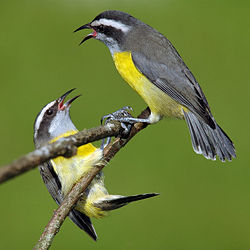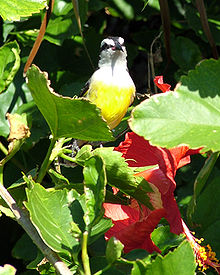- Bananaquit
-
Bananaquit 
Conservation status Scientific classification Kingdom: Animalia Phylum: Chordata Class: Aves Order: Passeriformes Suborder: Passeri Family: Thraupidae Genus: Coereba
Vieillot, 1809Species: C. flaveola Binomial name Coereba flaveola
(Linnaeus, 1758)Synonyms Certhiola martinicensis
Certhiola dominicanaThe Bananaquit (Coereba flaveola) is a species of passerine bird of uncertain relation. It is tentatively placed in the tanager family, but classified as incertae sedis by other authorities such as the American Ornithologists' Union. Its classification is debated, and it is often placed in its own family: Coerebidae. It has recently been suggested the Bananaquit should be split into three species, but this has yet to receive widespread recognition. This small, active nectarivore is found in warmer parts of the Americas, and is generally common.
Contents
Taxonomy
The Bananaquit was first described by Linnaeus in his Systema Naturae in 1758 as Certhia flaveola.[2] It was reclassified as the only member of the genus Coereba by Louis Jean Pierre Vieillot in 1809.[3] Prior to 2005 the Bananaquit was assigned to the monotypic family Coerebidae; there is currently no agreement to which family it belongs; some authors place it into the Emberizidae.[4] Since recent studies have shed some light on the Bananaquit's affinities, many authorities consider Coerebidae an obsolete taxon. The Coerebidae used to contain other nectar-eating birds from the tropical Americas, but these have since been moved. The Bananaquit is part of a group that includes the Darwin's finches, Tiaris (grassquits), Loxigilla, etc.—most of which were previously placed in Emberizidae, but are now known to actually be part of the Thraupidae.[5] As such this species is tentatively placed in the Thraupidae family unless a study suggests more accurate placement. Nevertheless, its precise relations remain unresolved, so the American Ornithologists' Union thus classes it as species incertae sedis.[6]
It is still unclear if any of the island subspecies actually should be elevated to species, but phylogenetic studies by Seutin et al. and Bellemain et al. have revealed three clades: The nominate group from Jamaica, Hispaniola and the Cayman Islands, the bahamensis group from the Bahamas and Quintana Roo, and the bartholemica group from South and Central America, Mexico (except Quintana Roo), the Lesser Antilles and Puerto Rico.[7][8] Several taxa were not sampled, but most of these are easily placed in the above groups based on zoogeography alone. Exceptions are oblita (San Andrés Island) and tricolor (Providencia Island), and their placement is therefore uncertain.[7][8] Bellemain et al. suggested that the two taxa, bahamensis and bartholemica, be split, and in February 2010, the International Ornithological Congress listed as proposed splits from C. flaveola.[9]
 Illustration by Joseph Smit, 1886
Illustration by Joseph Smit, 1886
Subspecies
- C. flaveola alleni Lowe, 1912
- C. flaveola aterrima (Lesson, 1830)
- C. flaveola atrata (Lawrence, 1878)
- C. flaveola bahamensis (Reichenbach, 1853)
- C. flaveola bananivora (Gmelin, 1789)
- C. flaveola barbadensis (Baird, 1873)
- C. flaveola bartholemica (Sparrman, 1788)
- C. flaveola bolivari Zimmer & Phelps, 1946
- C. flaveola bonairensis Voous, 1955
- C. flaveola caboti (Baird, 1873)
- C. flaveola caucae Chapman, 1914
- C. flaveola cerinoclunis Bangs, 1901
- C. flaveola chloropyga (Cabanis, 1850)
- C. flaveola columbiana (Cabanis, 1866)
- C. flaveola dispar Zimmer, 1942
- C. flaveola ferryi Cory, 1909
- C. flaveola flaveola (Linnaeus, 1758)
- C. flaveola frailensis Phelps & Phelps Jr, 1946
- C. flaveola gorgonae Thayer & Bangs, 1905
- C. flaveola guianensis (Cabanis, 1850)
- C. flaveola intermedia (Salvadori & Festa, 1899)
- C. flaveola laurae Lowe, 1908
- C. flaveola lowii Cory, 1909
- C. flaveola luteola (Cabanis, 1850)
- C. flaveola magnirostris (Taczanowski, 1880)
- C. flaveola melanornis Phelps & Phelps 1954
- C. flaveola mexicana (Sclater, 1857)
- C. flaveola minima (Bonaparte, 1854)
- C. flaveola montana Lowe, 1912
- C. flaveola nectarea Wetmore, 1929
- C. flaveola newtoni (Baird, 1873)
- C. flaveola oblita Griscom, 1923
- C. flaveola obscura Cory, 1913
- C. flaveola pacifica Lowe, 1912
- C. flaveola portoricensis (Bryant, 1866)
- C. flaveola roraimae Chapman, 1929
- C. flaveola sharpei (Cory, 1886)
- C. flaveola tricolor (Ridgway, 1884)
- C. flaveola uropygialis Berlepsch, 1892
Description
The Bananaquit is a small bird, although there is some degree of size variation across the various subspecies. Length can range from 7.5 to 12.5 centimetres (3.0 to 4.9 in).[10][11] Weight ranges from 5.5 to 19 grams (0.19 to 0.67 oz).[12][13]
Most subspecies of the Bananaquit have dark grey (almost black) upperparts, black crown and sides of the head, a prominent white eyestripe, grey throat, white vent, and yellow chest, belly and rump.
The sexes are alike, but juveniles are duller and often have a partially yellow eyebrow and throat. In the subspecies bahamensis and caboti from the Bahamas and Cozumel, respectively, the throat and upper chest are white or very pale grey,[14][15] while ferryi from La Tortuga Island has a white forehead.[16]
The subspecies laurae, lowii and melanornis from small islands off northern Venezuela are overall blackish,[16] while the subspecies aterrima and atrata from Grenada and Saint Vincent have two plumage morphs, one "normal" and another blackish.[14] The pink gape is usually very prominent in the subspecies from islands in the Caribbean Sea.
Behaviour
It has a slender, curved bill, adapted to taking nectar from flowers. It sometimes pierces flowers from the side, taking the nectar without pollinating the plant.[17]
It cannot hover like a hummingbird, and must always perch while feeding. It will also eat fruit and insects. It often visits gardens and may become very tame. Its nickname, the sugar bird, comes from its affinity for bowls or bird feeders stocked with granular sugar, a common method of attracting these birds.[citation needed]
The Bananaquit builds a spherical lined nest with a side entrance hole, laying up to three eggs, which are incubated solely by the female.[4]
Distribution
It is resident in tropical South America north to southern Mexico and the Caribbean. It is found throughout the West Indies, except Cuba.[14] Birds from the Bahamas are rare visitors to Florida.[17]
It occurs in a wide range of open to semi-open habitats, including gardens and parks, but it is rare or absent in deserts, dense forests (e.g. large parts of the Amazon Rainforest) and at altitudes above 2,000 metres (6,600 ft).[16]
References
- ^ BirdLife International 2009
- ^ Linnaeus 1758, p. 119
- ^ Vieillot 1809, p. 70
- ^ a b Monteiro Pereira 2008, p. 120
- ^ Burns, Hackett & Klein 2002
- ^ American Ornithologists' Union 2008
- ^ a b Seutin et al. 1994
- ^ a b Bellemain, Bermingham & Ricklefs 2008
- ^ "Updates: Candidates". IOC World Bird List. http://www.worldbirdnames.org/updates-PS.html. Retrieved 21 October 2011.
- ^ "Bananaquit". anywherecostarica.com. http://www.anywherecostarica.com/flora-fauna/bird/bananaquit. Retrieved 21 October 2011.
- ^ "Bananaquit". enature.com. http://www.enature.com/fieldguides/detail.asp?recNum=BD0577. Retrieved 21 October 2011.
- ^ "Bananaquits". birdingguide.com. http://www.birdingguide.com/bird_families/bananaquits.htm. Retrieved 21 October 2011.
- ^ Diamond 1973
- ^ a b c Raffaele et al. 1998
- ^ Howell & Webb 1995
- ^ a b c Restall, Rodner & Lentino 2006
- ^ a b Dunning 2001
Literature cited
- American Ornithologists' Union (2008). "Check-list of North American Birds". http://www.aou.org/checklist/north/full.php. Retrieved 5 January 2009.
- Bellemain, Eva; Bermingham, Eldredge; Ricklefs, Robert E. (2008). "The dynamic evolutionary history of the bananaquit (Coereba flaveola) in the Caribbean revealed by a multigene analysis". BMC Evolutionary Biology 8: 240. doi:10.1186/1471-2148-8-240. PMC 2533019. PMID 18718030. http://www.pubmedcentral.nih.gov/articlerender.fcgi?tool=pmcentrez&artid=2533019.
- "Coereba flaveola". IUCN Red List of Threatened Species. Version 2009.2. International Union for Conservation of Nature. 2009. http://www.iucnredlist.org/apps/redlist/details/149896.
- Burns, K. J.; Hackett, S. J.; Klein, N. K. (2002). "Phylogenetic relationships and morphological diversity in Darwin's finches and their relatives". Evolution 56 (6): 1240–1252. PMID 12144023. http://eebweb.arizona.edu/courses/galapagos/handouts%202009/articles%202009%20for%20web/phylogenetic%20relationships.pdf.
- Diamond, A. W. (1973). "Altitudinal variation in a resident and migrant passerine on Jamaica" (PDF). The Auk 90 (3): 610–618. http://elibrary.unm.edu/sora/Auk/v090n03/p0610-p0618.pdf.
- Dunning, John B. Jr (2001). "Bananaquit". In Elphick, Chris; Dunning, John B. Jr.; Sibley, David Allen. The Sibley Guide to Bird Life and Behavior. New York: Alfred A. Knopf. pp. 510–511. ISBN 978-1-4000-4386-6.
- Howell, S. N. G.; Webb, S. (1995). A Guide to the Birds of Mexico and Northern Central America. London: Oxford University Press. ISBN 0-19-854012-4.
- Linnaeus, C (1758) (in Latin). Systema naturae per regna tria naturae, secundum classes, ordines, genera, species, cum characteribus, differentiis, synonymis, locis. Tomus I. Editio decima, reformata.. Holmiae. (Laurentii Salvii).. p. 119. "C. nigra, uropygio pectoreque luteo, superciliis macula alarum rectricümque apicious albis"
- Monteiro Pereira, José Felipe (2008) (in Portuguese). Aves e Pássaros Comuns do Rio de Janeiro. Rio de Janeiro: Technical Books. ISBN 978-85-61368-00-5.
- Raffaele, Herbert; Wiley, James; Garrido, Orlando; Keith, Allan; Raffaele, Janis (1998). A Guide to the Birds of the West Indies. Princeton: Princeton University Press. ISBN 978-0-691-08736-8.
- Restall, R. L.; Rodner, C.; Lentino, M. (2006). Birds of Northern South America – An Identification Guide. London: Christopher Helm. ISBN 0-7136-7242-0.
- Seutin, G; Klein, N. K.; Ricklefs, R. E.; Bermingham, E. (1994). "Historical biogeography of the bananaquit (Coereba flaveola) in the Caribbean region: a mitochondrial DNA assessment". Evolution 48 (4): 1041–1061. doi:10.2307/2410365. JSTOR 2410365.
- Vieillot, Louis Jean Pierre (1809) (in French). Histoire naturelle des oiseaux de l'Amérique septentrionale. Paris: Desray.
External links
 Data related to Coereba flaveola at Wikispecies
Data related to Coereba flaveola at Wikispecies Media related to Coereba flaveola at Wikimedia Commons
Media related to Coereba flaveola at Wikimedia Commons- Bananaquit videos on the Internet Bird Collection
- Stamps (with range map)
- Bananaquit sounds on xeno-canto.org
Categories:- IUCN Red List least concern species
- Coerebidae
- Birds of Puerto Rico
- Birds of Grenada
- Birds of Saint Vincent and the Grenadines
- Birds of South America
- Birds of the Amazon Basin
- Birds of the Guianas
- Birds of Marajó Island
- Birds of the Cerrado
- Birds of the Caatinga
- Birds of the Pantanal
- Birds of Central America
- Birds of the Caribbean
- Birds of the Greater Antilles
- Birds of the Lesser Antilles
- Bird families
- Genera of birds
- Monotypic bird genera
- Animals described in 1758
- Monotypic bird families
Wikimedia Foundation. 2010.





